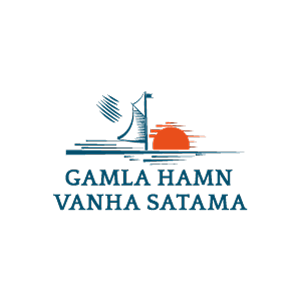Old Harbour – a cultural and historical resource
Guy Björklund, Jakobstad museum
Old Harbour – a cultural and historical resource
Gamla hamn i Jakobstad utgör idag den innersta delen av en havsvik, som sträcker sig i nord-sydlig riktning, nordväst om Jakobstads centrum. Hamnviken, som den också kallas, fick under många decennier ta emot stadens avloppsvatten och var därför dömd att helt slammas igen. Då staden i slutet av 1970-talet fick ett nytt reningsverk och nedsmutsningen av Gamla hamn upphörde, aktualiserades planerna på att restaurera den gamla hamnviken. Den hade nu blivit så nedsmutsad och uppgrundad att den nästan hade blivit helt oanvändbar.
Gamla hamnområdet hörde ända till 1950-talet både till Jakobstad och till Pedersöre. Gränsen gick mitt i hamnviken så att den södra och östra stranden hörde till Jakobstad medan den västra hörde till Vestersundsby i Pedersöre. I första hand var tanken att Gamla hamn skulle ge nya och bättre båtplatser för nöjesbåtarna, men nu framkom idén att skapa en helhetsplan för hela Gamla hamnområdet. Stadsstyrelsen tillsatte en kommitté 1985, som skulle utreda den framtida användningen av området. Samma år delgav kommittén sin rapport, där man som grund för områdets utveckling har satt områdets miljömässiga och kulturhistoriska särdrag och resurser. Gamla hamnområdet har redan sedan början av seklet varit ett naturligt rekreationsområde för jakobstadsborna. Här har funnits simhus, dansplats, nöjespark, segelpaviljong, som marvillor och strövområde. I framtiden skall området fortsättningsvis fungera som ett rekreationsområde.
De kulturhistoriska resurserna som finns i området har varit endast delvis kända, eftersom det inte har gjorts några större inventeringar eller undersökningar rörande Gamla hamn. Jakobstads museum har genom de aktuella planerna fått på sitt ansvar att utföra en grundforskning av det gamla hamnområdet och utföra en inventering av de funktioner och anläggningar som har varit förknippade med området.
Den viktigaste resursen är själva hamnen med hamnanläggningar ss. lastbryggor, magasin, båthus och lämningar av produktionsanläggningar ss. beckbruk, skeppsvarv, repslagarbana m.m.
The harbour and harbour facilities
The name Old Harbour dates back to the latter part of the 1800s, when the city had already acquired a new harbour facility further out on the shore of Alholmen. Old Harbour had its greatest significance as a harbour from the early 1600s to the 1830s, and when the tar trade ceased in the late 1850s, Old Harbour also lost its function as a storage place for tar. After that, the harbour was downgraded to a small boat and fishing harbour, and today it is dominated by recreational boats.
The history of Old Harbour goes back much further than 1652, when Jakobstad was founded. Thanks to the harbour, the city was established in its current location. In 1652, Ebba Brahe wrote in her foundation letter to her steward, Henric Tavast at Pinnonäs farm, that he should find a suitable place for the city near the harbour. The harbour referred to was the so-called Pedersöre harbour, which at that time included Old Harbour and its continuation inland, later called Stadssundet.
In its early years, Jakobstad had to fight against its neighbours, Nykarleby to the south and Gamlakarleby to the north, to retain its city privileges. In their defence, the city's citizens argued that Jakobstad had the best harbour in Ostrobothnia. They appealed to the king several times during the 1600s on this matter and also obtained certificates attesting to the harbour's excellence. One of these was written by Påhl Lijtheen, who was the commander of the crown's ship, 'St. Philippus,' which was in the city's harbour in 1682. Lijtheen wrote that the harbour had a 'good entrance,' without major shoals, and that the average depth in the harbour bay was 12-13 feet, and that ships could lie next to the shore warehouses and take on cargo. In 1686, Commander Christoffer Vernich, later ennobled as Wernfeldt, also certified that he had sought winter harbour in Jakobstad without any problems with two of the crown's cargo ships, each 110 feet long and with a draught of 9 feet when fully loaded.
These certificates came to have great significance. This can be seen in the responses that the magistrate in Jakobstad received, which almost verbatim contained the same statements about the harbour as those given in the certificates. These certificates are also the oldest descriptions of the harbour and the oldest indications of the water depth in the harbour. From the latter part of the 1700s, there are several descriptions of the harbour and also more maps that provide more detailed information about the harbour. Jakobstad's first historian, Hans Henric Aspegren, formulated himself in 1763 as follows when describing the harbour: 'the harbour's equal for outlet and anchorage is probably sought in vain in any city in Ostrobothnia...
Other contemporary descriptions were made by surveyor Jonas Cajanus in 1762, customs inspector Eles in 1773, and mayor Natanael Häggström, who under a pseudonym wrote a longer series of articles in Tidningar utgifna af ett Sällskap i Åbo in 1784. All these descriptions and articles from the late 1700s had a very specific purpose, namely to prepare the ground for freedom of navigation and extended customs rights for the city.
Topographically, the harbour had a good location as it was well protected from most winds. Kittholmen provided shelter from the harsh northern winds, and therefore tree felling on Kittholmen was prohibited. The prohibition was categorically repeated every year throughout the 1700s. To the south and southwest, Biskopsholmen, Skutkull, and Skutnäs sheltered the harbour bay from the winds. The natural conditions alone are not enough to create a functioning harbour; various types of facilities are also needed to facilitate operations in the harbour. Sheltered by the forest on the southern shore of Kittholmen was the harbour's loading area with warehouses and tar storage. The shore was shallow, so loading piers had to be built out into the harbour bay, where the ships could dock.
There were also warehouses and tar storage on a peninsula, Biskopsholmen, southeast of the harbour bay. In 1734, it was decided to construct a pile structure to reinforce the shore and facilitate loading. An older pile structure had existed at Nätinabban but was destroyed during the Great Northern War and rebuilt in 1722. In the 1750s, there were also plans to send a person to Stockholm to learn how to construct pile structures. Whether these plans were carried out is not known.
In the harbour bay, there was also a common careening wharf, mainly used for careening ships. In 1770, it was considered that the old careening wharf had become 'unserviceable' due to continued silting. The old careening wharf was sold at auction to merchant Sten, and ten of the city's merchants joined forces to build a new careening wharf. The merchants requested permission to fell the necessary timber in Kittholmen forest for the careening wharf. This careening wharf could only be used for a few decades before it became unusable. Instead, the third careening wharf of the 1700s was built at Storoll notvarpet, which was the harbour roadstead, outside Carlholmen. In the early 1800s, the centre of the harbour and the loading area shifted further out, so that it came to be located west of Kittholmen. Here, a couple of larger tar storage buildings still remain, and the place still retains the character of an old harbour site. Both at the older and the newer loading areas, several so-called 'tar bottoms,' floors from tar storage buildings, remain.
The Harbour Customs
The actual harbour customs were located on the shore of Stadssundet, at the northern end of Surbrunnsgatan, later Hamngatan. When boat traffic from the harbour bay to the city along Stadssundet ceased in the early 1700s, it became impossible to monitor trade in the harbour from the city. Therefore, in 1753, it was planned to build a guardhouse for the customs on Biskopsholmen, but instead, the sea customs were placed at the loading area on Kittholmen. From here, it was much easier to oversee activities in the harbour area.
In 1767, Jakobstad received staple rights but lacked the right to clear goods for foreign trade. These goods had to be cleared in Gamlakarleby, which was naturally a great disadvantage for shipping and significantly hindered trade. In 1797, Jakobstad was relieved of this inconvenience when full customs rights were granted.
Adjacent to the customs house, there was also a primitive balance scale in the open air. It consisted of a trestle and a plank, with two large baskets. Goods were placed in one basket and weights in the other. Since it was difficult to obtain weights, ordinary stones were used, on which their weight was noted. The city's regular weigh house was located in the middle of the city and could therefore not be used.
The city's customs officer, Baron Falkenberg, was not satisfied with the placement of the sea or harbour customs. He believed it should be moved to the north-western shore of Kittholmen so that it would be possible to monitor the harbour roadstead and the entrance to the city, including the smaller fairway that ran east of Kittholmen. In 1773, customs inspector J. Elers wrote a longer description of the customs situation in Jakobstad.
The description was also supplemented with a map, redrawn in 1794 by Gyllenborg. Both the description and the map provide a good picture of trade and shipping in Jakobstad during the latter part of the 1700s. The city did not get a new harbour customs during the Swedish period. In 1827, a new customs pier was built, and probably a new customs house was also erected at the pier. The new customs pier was built right at the mouth of the harbour bay. The pier still exists and has been used for various purposes in recent times, but the name, Tullbron, remains.
Industrial and Factory Facilities
Naturally, various types of industries and factories, both large and small, were drawn to the harbour area in Jakobstad, just as in other places. The Old Harbour area also became the town's first industrial area. The oldest production facilities were those associated with shipping. Within the Old Harbour area, there have been several shipyard facilities, and it is likely that the Momma brothers' shipyard was located here between 1666 and 1672.
The head of the Momma shipyard in Jakobstad, Elias Gavelius, wrote in a letter to Abraham Momma that he had chosen a site for the shipyard near the town's harbour, at a distance of two musket shots from the town. The shipyard site was probably on Kittholmen. Within the Old Harbour area, there have been shipyard beds on many of the surrounding islets. The most well-known of these are Vattungen and Carlholmen. Vattungen was the common building site for the people of Pedersöre since ancient times, but due to the fear that the shavings from the shipyards would silt up the harbour bay, all shipyard activities within the harbour area were prohibited. Vattungen then served as the loading place for the people of Pedersöre and later as a repair site for harbour barges well into the 20th century.
In 1777, merchant Winsten applied to build a ship next to his tar sheds on Kittholmen, but the application was rejected. The town then began to discuss a suitable site outside the harbour for a common shipyard facility. By 1797, ten of the town's merchants had come together to form a shipyard company. The shipyard was placed on Carlholmen, west of the harbour roadstead. The shipyard was named Carlholmen's Shipyard. The islet was leased for 100 years by the Vestersundsby village association, and during these years the shipyard remained. Both communal and private buildings were erected at the shipyard. A shipyard guard was also employed, who lived at the shipyard. At Carlholmen's shipyard, over 150 sailing ships were built between 1797 and 1874. So, it is not without reason that the area is called Varvet (the Shipyard) today.
Jakobstad's first factory, the pitch works, was also established in 1753 at the Old Harbour, specifically at Nätinabban south of the harbour bay. The pitch works operated as a company in which some of the town's merchants had shares. In connection with the pitch works, a shed was built for the pitch cauldron itself, a cottage with a porch for the pitch burner, and sheds for storing tar, pitch, and tarred rope. The pitch works initially had a pitch pan that held 40 barrels of tar, but larger pans were acquired over time, so that the last cauldron held 60 barrels.
Production was at its peak during the 18th century with about 1500 barrels of pitch per year, and in the early 19th century about 1000 barrels annually. The pitch works were used for the last time in the 1880s.
Around 1800, a ropewalk was established on Kittholmen. For this purpose, a straight and wide street was cleared through the forest. Previously, there was a ropewalk just outside the town's northern toll gate next to the tobacco spinning mill, along the so-called Hampspinnaregatan. As the town grew northwards, the ropewalk had to be moved. The ropewalk on Kittholmen, or as it is called today Banavägen, is a very prominent remnant of a craft that was so important for shipbuilding.
Within the Old Harbour area, there have been several smaller and larger workplaces, ranging from smithies to mechanical workshops, from food sales to breweries, facilities that would make this presentation too extensive. It can finally be stated that the Old Harbour was the town's most important industrial area as long as the harbour bay could function as the town's harbour until the mid-19th century.
Defence of the Harbour
There have not been any major defence installations in the Old Harbour; generally, a passive defence has been relied upon. This has involved removing all buoys, beacons, and other markers indicating the channel into the harbour during troubled times. However, on the western shore of Kittholmen, there is a small redoubt that was constructed in 1854 during the Crimean War, when the English fleet was active in the Gulf of Bothnia. Two cannons were brought from Oravais for the fortification, and a small road was built through the Kittholm forest for their transport, which is still called Kanonvägen (Cannon Road) today. Further out on Alholmen, a fortification for the harbour and the town was also constructed. The site was later called "Batteriudden" (Battery Point).
Land Uplift and Silting
The greatest problem for the harbours along the Ostrobothnian coast has been land uplift, and this has also affected the Old Harbour. To prevent too rapid silting, several different prohibitions were introduced concerning the harbour bay, including the aforementioned ban on shipbuilding in the harbour, dumping of ballast, etc.
In 1774, the town councillors discussed a proposal for harbour regulations in accordance with a royal letter. In the economic protocol from the same year, it is noted very pessimistically that: "something peculiar, which would serve to improve the harbour, as the receding water on the low shores has mostly contributed to the silting of our harbour, which could hardly be helped at all..."
t was further noted that a new harbour site further out must be sought, and efforts should be made to protect the channel and the roadstead from being filled with ballast.
Land uplift has varied over different periods, and today it is estimated at 8 mm/year or just over 80 cm/100 years. Equally significant has been the silting, which in some parts of the Old Harbour area has been considerable.
From the late 17th century, there are records of the water depth in the harbour bay inside Vattungen. In the 1680s, the depth was 12-13 feet, during the 1770s it was 8-9 feet, and by the late 19th century, it was about 5 feet. In approximately 200 years, the water depth had decreased by 7-8 feet, which would mean an accretion of just over 1 inch/100 years.
Summary
The Old Harbour area has been of great significance to the town's maritime and economic development. For nearly 200 years, the Old Harbour served as the town's port and centre for shipping, trade, and industry. Since the Old Harbour area lost its economic importance, it has become increasingly important as a recreational area. Summer cottages were built on Kittholmen as early as the late 19th century. Similarly, the Volunteer Fire Brigade established a festival ground here in 1890, which has since been used for various summer entertainment events.
Through dredging carried out between 1984 and 1986, the area's attractiveness was also increased, creating new opportunities for a vibrant marina. The Old Harbour area has been spared from overly intensive exploitation, which also means that many visible remnants of activities in the Old Harbour remain. Therefore, the Old Harbour represents a resource for the future, a recreational area for both body and soul. With this in mind, the plans for the area include, among other things, a historical museum, a full-scale shipbuilding project, Jacobstad's Wapen from 1767, a marine-themed amusement park, and more.
Sources
Unpublished Sources:
Jakobstad Museum:
New Toll Bridge, accounts 1827.
Pitch Works, accounts 1801 - 29.
Maps and town plans 1693 - 1860.
Object catalogues 1984-86.
Jakobstad Central Archive:
Economic protocols 1729 - 1877.
Property maps.
Copy of customs inspector J. Elers' description 1773.
Printed Sources:
Ahlström, Alarik; Jakobstad's Harbour and its Silting. Pedersöre Christmas and Local History Supplement 1924.
Björklund, Guy; The Pitch Works - Jakobstad's First Factory. Pedersöre Christmas and Local History Supplement 1924.
Calonius, Allan; The Causes of the Emergence of the Towns Nykarleby, Jakobstad, and Gamlakarleby. Fennia 80 No. 2. Helsinki 1957.
The Town of Jakobstad. Kittholmen, report 31.5.1985.

Shipyard – museum:
Open:
9.6 -1.8.2025 from 10:00 to 16:00
Admission:
Adults 10 €
Children 12-17 years 5 €
Children under 12 years free
The museum card is valid with us
Other times by appointment.
Call 050 5947814
Vega Foundation
info@vegastiftelsen.fi
Maria Lunabba tel: 050 594 7814
Vega Foundation tel: 044 242 2073
Visiting address:
Gamla Hamnvägen 19, Jakobstad
Postal address:
c/o Lunabba, Loveret 1 A, 68600 Jakobstad
Gamla Hamn i Jakobstad rf
gamlasatama@gmail.com
If you want to become a member of our association, contact us at gamlasatama@gmail.com
or call 050 5947814
Jakobstads Gamla Hamn Ab
peter.bostrom@datic.fi

 Svenska
Svenska Suomeksi
Suomeksi
